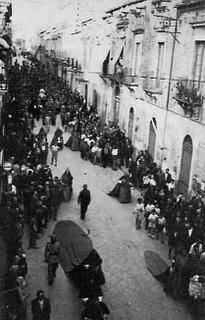Canons are ecclesiastical dignitaries attached to "chapters," which exist in certain cathedrals and other greater churches. Originally, chapters gave the clerics a common life and provided for the singing of the canonical hours (and the performing of other sacred duties) in the churches that had them. With time, other responsibilities were given to canons, and in some dioceses the cathedral chapter wielded considerable power, including the naming of the bishop. In those places that have canons nowadays, their role is often merely honorary (as is the case with monsignori), although some are still obliged to certain sacred responsibilities within the chapter, and some still have special authority.
We mention the canons here because, within their chapter, canons usually enjoy special vestural privileges. These privileges vary from chapter to chapter: in some places, the canons wear mozzettas or mantellettas of this or that color, in others the biretta is modified, in some a cappa is allowed, or fur, or vesture that is almost indistinguishable from that of a bishop. As this photopost grows, we'll accept submissions of pictures depicting and describing the vesture of specific chapters. European readers: we're counting on your help!
The canons of the
Cathedral Chapter of Warsaw, Poland are wearing the violet manteletta over rochet and black cassock, with purple trim and fascia. On chains, over the manteletta, each canon wears a chapter cross.
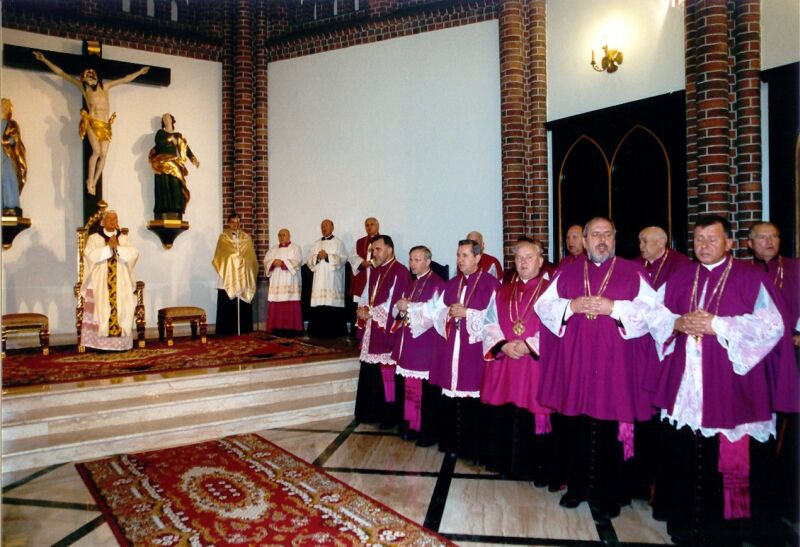
The canons of the
Cathedral Chapter of Salzburg, Austria, wear cherry red birettas and mozzettas, with a chapter cross on a cherry red ribbon.
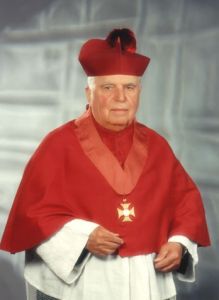
The canons of the
Capitular Chapter of the Collegiate Basilica of St. Helen Empress Augusta in Malta enjoy vestural privileges granted by Pope Urban VIII in the Papal Bull
Sacri apostolici ministerio on the 5th December 1630, through which he erected the said chapter on the petition of Don Filippo Borgia. The following is their choir vesture: a rochet over the cassock, a cappa magna fastened at the back, (the reversed diaconal stole is part of the cappa) and a black biretta. Pope Leo XIII granted the use of a pectoral cross and a ring in 1862. The Capitular Mace was granted in 1914. Pius XII elevated the Collegiate Church to a Minor Basilica in 1950, granting the privilege of using the papal umbrellone and the tintinnabulum.
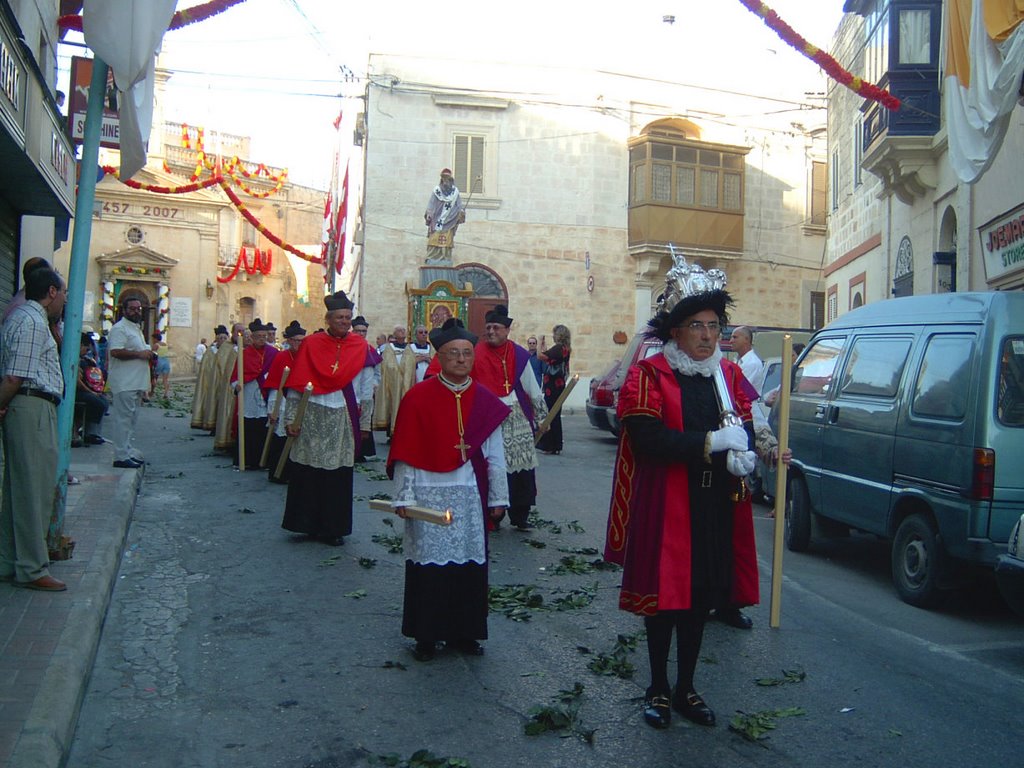
The collegiate chapter of the Basilica of Sts Peter and Paul in Gozo, Malta, seem to have the same privileges as the above Basilica of St Helen: folded purple cappa, with the odd reversed diaconal stole, over rochet and black cassock, with rings and unjeweled pectoral crosses. The two canons in the lead, wearing red tufted birettas and full purple and purple-piped cassocks respectively, presumable enjoy some special dignity. Notice, too, the tintinnabulum (processional bells) and umbrellone of the basilica, as well as the chapter mace carried by a verger.
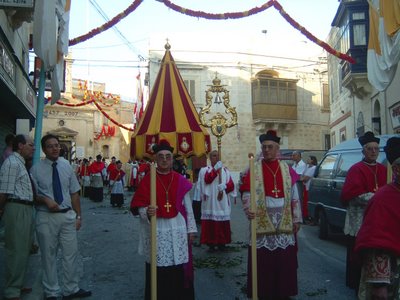
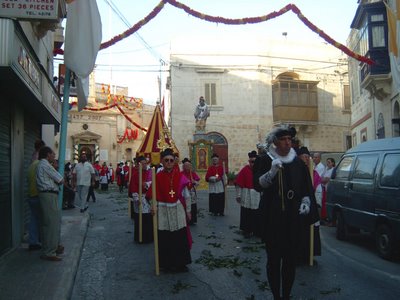
The canons of the
Cathedral Chapter of Malta have two types of choir dress, I am told. The first image shows a cathedral canon in normal choir dress: purple mozetta, unjewelled gold pectoral cross on a golden cord, a black biretta with red pom-pom, rochet, over a black cassock with purple trim. On feast days, this filettata cassock is replaced by a full purple (paonazza) one. The cathedral canons of Malta have the privilege of being all protonotaries apostolic
ad instar. In the third photo, you see Metropolitan Archbishop Joseph Mercieca wearing the cappa magna (held by Seminarian Stephen Attard, who provided us with the photo) and attended by cathedral canons.
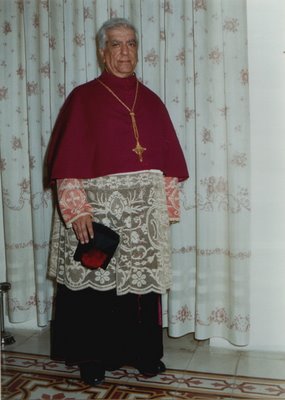


The canons of the
Cathedral Chapter of Cracow, Poland, seem to wear a black biretta with purple pom-pom, a ring, a capitular cross on a chain, and a violet cappa over rochet and black cassock.

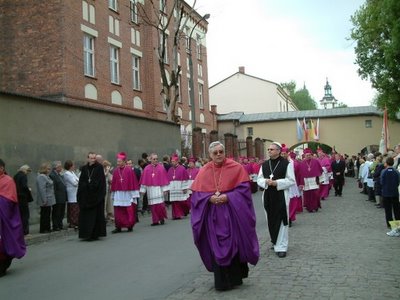

The canons of the
Cathedral Chapter of Swidnica, Poland, wear purple-tufted black birettas, a purple mozzetta with rochet, over a black cassock trimmed in purple. They use a ring and a capitular cross on a chain.

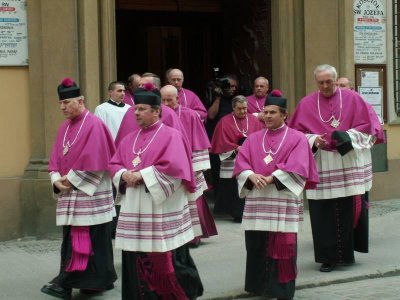
The canons of the
Cathedral Chapter of Kalisz, Poland, seem to have the same privileges as the Swidnica canons.
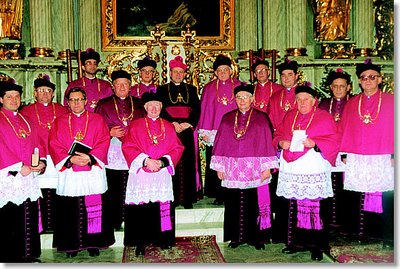
The
Co-Cathedral Chapter of Ostrowiec Wielkopolski, Poland, in the same Diocse of Kalisz, seem to have the same vesture as their colleagues in Kalisz Cathedral, except that they wear a purple manteletta instead of a mozzetta.

The
Cathedral Chapter of the Polish Army's Field Cathedral in Warsaw are seen here wearing capitular crosses on a chain, over the purple manteletta, with rochet and purple-trimmed black cassocks. I can't see whether they have rings. None of them is wearing a fascia (the cassock sash), which one would expect to be purple, and without seeing their birettas one would presume that they are completely black.
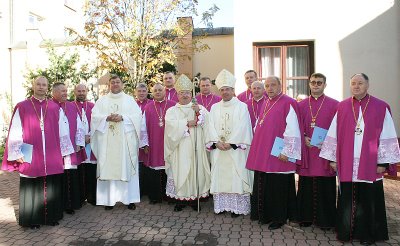
The
Collegiate Chapter in Biecz, Poland, (Diocese of Rzeszow) wears the black biretta with purple pom-pom, purple manteletta, a capitular cross on a very interesting chain, rochet, and a purple-trimmed black cassock. In some of the pictures, I'm noticing canons with black mantelettas and a different sort of cross: presumably, they belong to a different chapter.
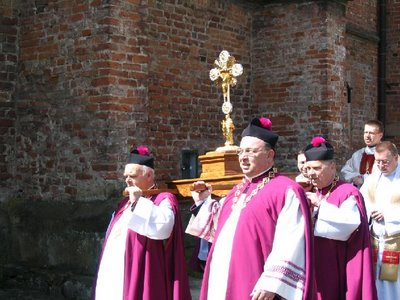
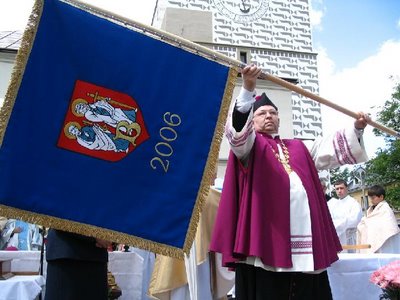
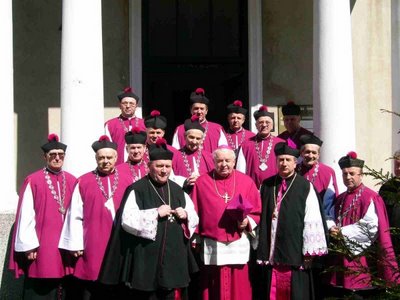
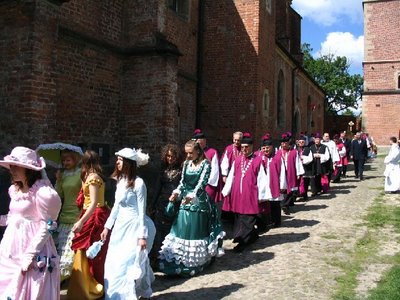
The
Cathedral Chapter of Glasgow, Scotland, used to wear this striking choir dress of a fur-trimmed purple mozzetta (with hood!) over rochet and purple cassock. I'm told that the Archbishop has retired the old canons and changed the choir dress to a purple-trimmed black cassock with a grey mozzetta.
Sic transit, I suppose.
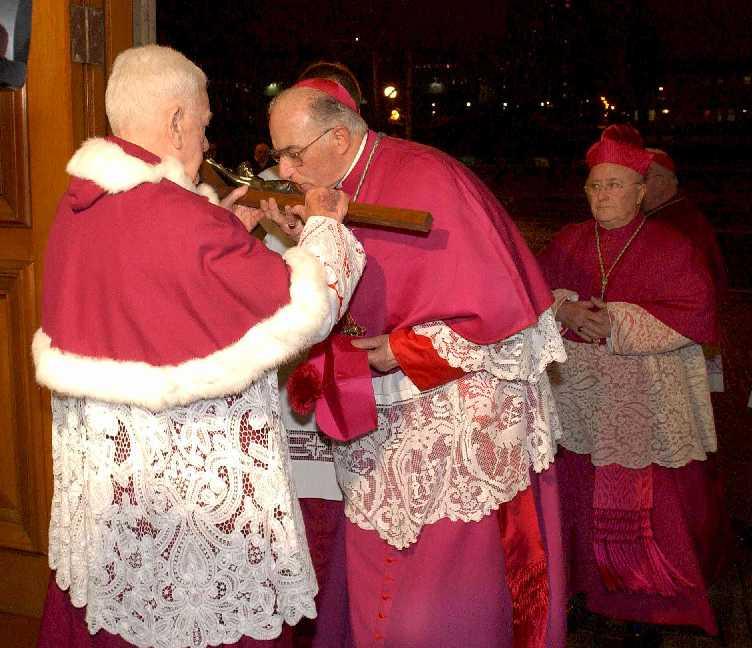
The
Canons of Avignon, France, enjoy vestural privileges that apparently date back to the days of the Popes' residence there. The monsignor seen here is dean of the chapter. Judging from the photo, the Avignon canons wear a scarlet cappa without a train, and a pectoral cross. Any more information?
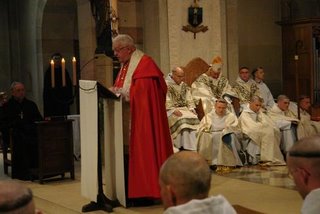

The
Cathedral Chapter of Southwark, England, wear a purple mozzetta with amaranth buttons and ermine trim. The two priests shown here are the provost and provost emeritus.
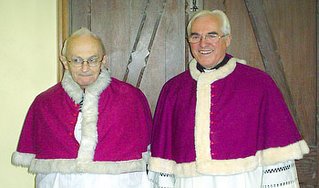
The canons of the
Collegiate Chapter of the Basilica of Guadalupe, Mexico, have two styles of choir dress, which I assume depend on the rank of the canon. Here we see one canon with purple mozzetta and chapter cross on a chain, over rochet (actually, it looks as if he's incorrectly in a surplice) and purple cassock; the other is wearing a purple-piped black mozzetta over a black cassock (perhaps also piped in purple?).
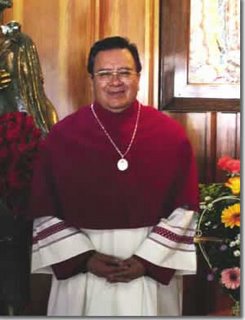
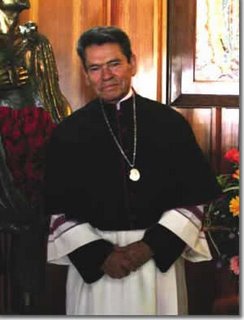
These canons of the
Cathedral Chapter of Merida, Spain, are wearing the black cappa trimmed in purple over rochets and black cassocks trimmed in purple.
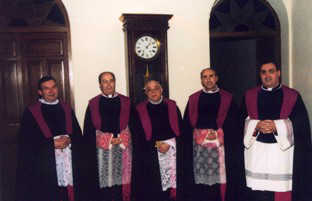
These canons of the
Cathedral Chapter of Segovia, Spain, wear black cappas with a violet uppper piece over rochet and (apparently) solid black cassocks.
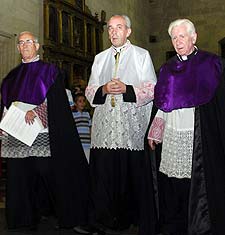
The canons of the
Cathedral Chapter of Augsburg, Germany, wear a purple mozzetta with a chapter cross on a ribbon, over rochet and full purple cassock.
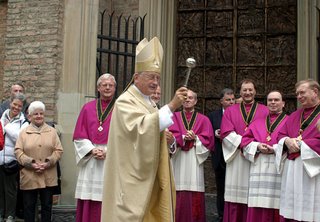
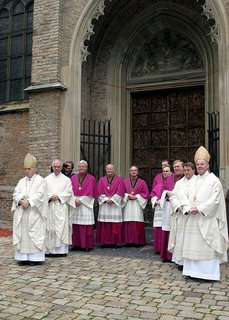
The canons of the
Cathedral Chapter of Orihuela-Alicante, Spain, wear what seems to be an oddly folded purple cappa magna, with an ermine-trimmed upper piece, over rochet and purple cassock. The canons are seen here in a Palm Sunday procession, complete with a bishop on a donkey!
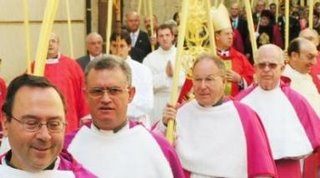
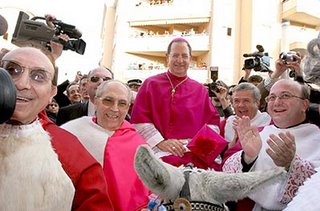

The canons of
the Cathedral Chapter of Quito, Ecuador, are seen here in an unusual custom called
arrastre de las caudas ("dragging of the trains"). They're wearing black cappa magna, with the train extended and (because they are involved in a penitential ceremony) with the hoods pulled over their heads. The rest of their vesture seems to be rochet and black cassock. In the first photo, you can see the diocesan bishop in his purple cappa, trimmed in ermine (technically no longer allowed for bishops), and his hood pulled over his head (and apparently biretta). I'll let my correspondent describe this ceremony:
It involves canons wearing the cappa with the
hood covering their head and caudatarii carrying the
trains. The canons then lie face down in choir and the
local bishop (also in cappa) presents a dark flag that
no one is supposed to touch. The whole thing takes
place during Wednesday of Holy Week and I do not
really know the symbolism behind it. The first photo shows the archbishop
of Quito, Ecuador, and the canons lying on the floor
during last year's "arrastre". The second photo is a
historic shot of the event.

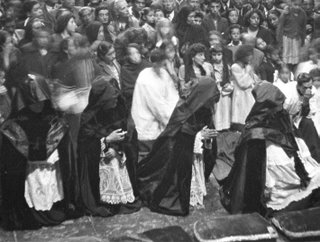
Unidentified Belgian canons, during the funeral of the Bishop of Bridge. They seem to be wearing black cappas with a striped-fur upper piece. Any more information?
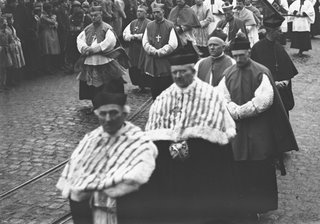

More
unidentified canons, these from Spain. They are wearing black cappas trimmed in burgundy velvet, over rochets and black cassocks. The priests in the middle don't seem to be dignitaries: the green pom-pom on their Spanish-style birettas is probably indicative of an academic degree (and thus ought not to be worn for purely liturgical ceremonies). Can anyone help identify the chapter in question?
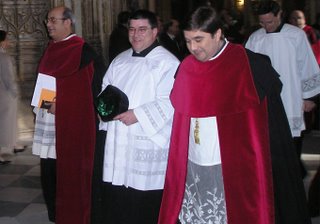

This photo is of the
Canons Regular of the Immaculate Conception, in Paterno, Italy. As regular canons, rather than capitular canons, these fellows are technically outside the scope of this particular post, but the photograph is too good to pass up. My correspondent explains what you are seeing:
These canons did not only
wear the violet cappa magna, the actually made a
procession through the town with the trains of the
cappa trailing behind them on the ground, as seen on
the photo. This was done every year on "Venerdi
Santo". To boot, these canons also wore socks and
zucchetto of matching color and buckled shoes. Of
course, this beautiful custom eventually came to and
end, too (Supposedly the provost one day saw the
archbishop amongst the spectators during the
procession. The provost felt sort of guilty that he
was dressed ten times as well as the archbishop and
instantly got rid of the cappae).
